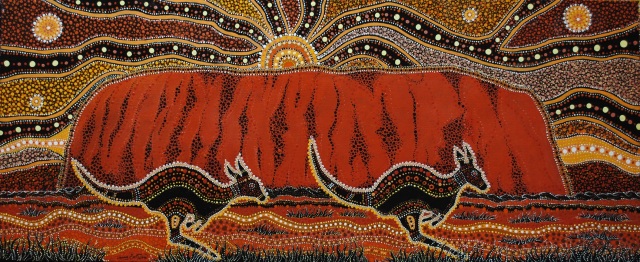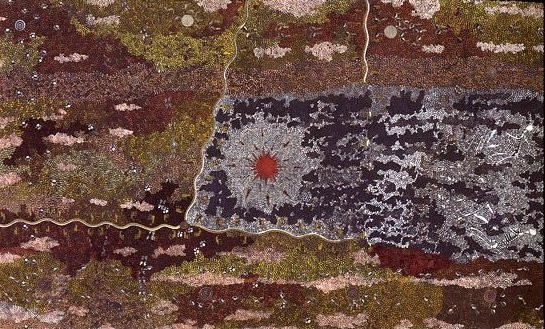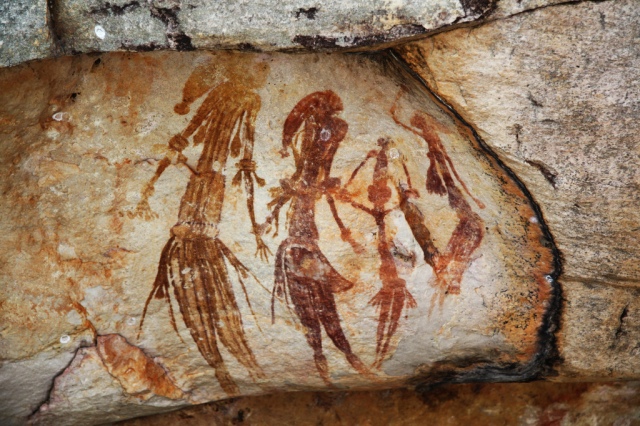Aboriginal art is art that comes from the indigenous people of Australia. Aboriginal art is some of the oldest known art in the world dating back more than 30,000 years ago. There are many different mediums of aboriginal art. The most popular of artwork can consist of rock paintings, rock engravings, dot paintings, wood bark painting, and wood carvings. Many rock paintings actually used forms of charcoal, clay, and natural dies to mark on stone walls. These depictions were usually of a historical or important event such as a successful hunt or an encounter with other tribes. Rock engravings are similar to rock paintings in subject matter but rather than coloring the surface of a rock face, indigenous people would carve out the stone. Dot paintings are the most popular traditional artwork in Australia. Dot paintings are made up of lots of dots and sometimes curving lines to form shapes. Yellows are used to represent the sun, brown for soil, red for dessert sand, and white for clouds and the sky. Other colors like blue and green are used to depict specific animals, plants, and people. While most of these paintings now are done on canvas many of the original traditional pieces were found done on wood. Authentic wood bark paintings are deemed highly valuable and can fetch a high dollar at auctions. Most paintings depict dessert landscapes of the back country outback with native animals and plants. There is also a very symbolic aspect of aboriginal art. Symbols used in some paintings were meant to convey rituals, foods, customs, spiritual encounters, constellations, and ceremonies. Symbols showed the presence of different objects that existed around them. Aboriginal tribes didn’t have their own written language so written communication was done through pictures and symbols. Art served both as beautiful creations and communication.

Danny Eastwood, a descendent of the Ngemba Tribe, painted Uluru. I was not able to find a date of creation but it is on display at the Karlangu Aboriginal Art Centre in Sydney, Australia. The title comes from the indigenous name for the large rock formation pictured. This is a sacred place for many aboriginal tribes as it connects them directly to the spiritual world and creation. Depicted is a great sunshine peeking out behind the rock, two kangaroos crossing the outback, and desert sand and grass. The painting is a contemporary rendition of traditional style. While this painting does not convey a story it does have traditional value with the spiritual subject matter.

The Dreamtime is an area of artwork that focuses on ancient stories and symbols that pertain to the world’s creation. Dreamtime stories, or dreamings, have been passed down through countless generations and are still being depicted today as they were tens of thousands of years ago. As previously mentioned before, dot paintings are very common in aboriginal cultures. Dots were used to hide secret information from white explorers who would be able to see and interfere with their sacred knowledge. The dots obscured the symbols in a way that wasn’t recognizable. This has since morphed into a classical style typified by artworks from the Pintupi tribe. Warlugulong is a painting done by Clifford Possum Tjapaltjarri in 1977. It is an acrylic on canvas and is the highest earning contemporary painting of any aboriginal art. He used the traditional dot style for this work. It sold at auction for $2.4 million. It depicts nine distinct dreaming symbols. The dreamings are separated by footprints. The most centrally focused on dreaming is of an ancient ancestral being named Lungkata who started the first bushfire. All the dreamings represent ancestral stories about events, people, and geographical locations.

The Bradshaw Rock Paintings is the name to describe one of two major traditional rock art in Australia. The art does not have a definitive age but dates back somewhere around 40,000 years ago (an approximation by archaeologists and rock reasearchers). The paintings were discovered by a shepherd named Joseph Bradshaw in 1891 while searching for pastoral lands in the northwest Kimberley region. The art consists primarily of human figures ornamented with accessories such as bags and headdresses. This style of art is interesting because it greatly differs from the other styles found in that area. The origin of the painting is unknown.
Works Cited:
Griffiths, Ellie. “8 Must-Visit Aboriginal Art Galleries In Sydney.” Culture Trip, 25 July 2016, theculturetrip.com/pacific/australia/articles/8-must-visit-aboriginal-art-galleries-in-sydney/.
Linklater, Scott. “The Story of Aboriginal Art.” Artlandish Aboriginal Art Gallery, 2 Sept. 2017, http://www.aboriginal-art-australia.com/aboriginal-art-library/the-story-of-aboriginal-art/.
“The Australian Rock Art Archive .” Bradshaw Foundation, 2011, http://www.bradshawfoundation.com/bradshaws/.
“10 Facts About Aboriginal Art.” Kate Owen Gallery, 2017, http://www.kateowengallery.com/page/10-Facts-About-Aboriginal-Art.aspx.

Thank you for your post! I was drawn in by the aboriginal dot art. It is beautiful. The intricacy of the art utilizing all of these dots and fine lines is quite impressive. The aboriginals are known for being a people who live with the land, meaning that they respect the earth and what it gives, living off of it. It is no wonder that they tended to use earth tones in their art; browns, reds, and yellows. I feel the Uluru you have posted here does indeed reflect this based on its subject matter. The sun shinning in the background with kangaroos jumping in the foreground. The grand mountains standing between them. The dots and curved lines set around the main subject add to the artistic appeal of the piece. Over all a beautiful creation! Here is a link for explore more aboriginal art from the aboriginal art gallery if you are interested! Thanks for your post and it’s been a pleasure working with you this semester.
https://www.aboriginal-art-australia.com/aboriginal-art-library/the-story-of-aboriginal-art/.
LikeLike
Whoa, this was really an interesting post and I really enjoyed the topic/culture you chose to write about. I love aboriginal culture, and so this was definitely something I was easily attracted to. I would like to know more about the historical stories behind the different artworks in the rocks like the last picture you present, “The Bradshaw Rock Paintings”. I think my favorite piece from your blog is the first picture with the kangaroo, “Uluru.” I cannot imagine how long it would have taken to create that painting with so much small detail. The artist must have had serious patience to be able to sit and create that. The painting is also so beautiful just in itself, I think that the colors used are just really organic and earthy. I would definitely own a piece of artwork like this to hang in my own home. I really appreciate your post! Thank you for sharing!
LikeLike